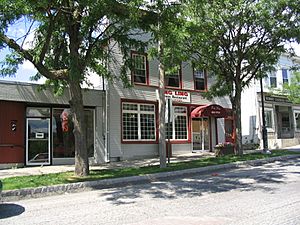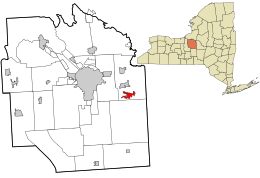Manlius (village), New York facts for kids
Quick facts for kids
Manlius, New York
|
|
|---|---|
|
Village
|
|

The downtown of the village of Manlius
|
|

Location in Onondaga County and the state of New York.
|
|
| Country | United States |
| State | New York |
| County | Onondaga |
| Village | 1813 |
| Area | |
| • Total | 1.82 sq mi (4.72 km2) |
| • Land | 1.82 sq mi (4.72 km2) |
| • Water | 0.00 sq mi (0.00 km2) |
| Population
(2020)
|
|
| • Total | 4,662 |
| • Density | 2,560.13/sq mi (988.60/km2) |
| Time zone | UTC-5 (Eastern (EST)) |
| • Summer (DST) | UTC-4 (EDT) |
| ZIP code |
13104
|
| Area code(s) | 315 |
| FIPS code | 36-45018 |
| GNIS feature ID | 2390961 |
Manlius is a small village in Onondaga County, New York, United States. It is located southeast of the city of Syracuse. In 2020, about 4,662 people lived there.
The Village of Manlius is found near the southern edge of the larger Town of Manlius. A special part of the village, about three blocks long, is listed on the National Register of Historic Places. This means it's a historically important area.
Contents
History of Manlius
Manlius was first settled in 1794. However, the village itself began two years earlier in 1792, thanks to a German settler named John A. Shaeffer.
The very first school in Manlius was built in 1798. It was a simple log cabin located near a local mill. By 1801, the village started to grow. It had six buildings and important services like a blacksmith, a store, a doctor, a lawyer, and a tavern. There was also a post office called "Liberty Square," which later became "Manlius Square."
Just four years later, Manlius grew very quickly. About thirty new houses were built. It became one of the most important business places in Onondaga County. In 1813, Manlius officially became the first village in the county.
Before the Erie Canal was built, Manlius was a major business stop. Goods traveled through Manlius on important roads like the Cherry Valley Turnpike and Seneca Turnpike. Many buildings along these roads were taverns, offering places for travelers to rest. Today, much of the Seneca Turnpike is part of New York State Route 173.
For twenty years, Manlius was the biggest trade center in Onondaga County. At that time, what is now Syracuse was mostly a swamp! Into the early 1900s, Manlius was also home to the St. John Military Academy. This was a well-known private school for young men.
The Manlius Village Historic District was added to the National Register of Historic Places in 1973. This helps protect its historical buildings and areas.
Geography of Manlius
Manlius is located at 43°0′8″N 75°58′44″W / 43.00222°N 75.97889°W.
The village covers a total area of about 1.8 square miles (4.6 square kilometers). All of this area is land.
Two main roads, New York State Route 92 and New York State Route 173, meet in Manlius.
Population of Manlius
| Historical population | |||
|---|---|---|---|
| Census | Pop. | %± | |
| 1860 | 873 | — | |
| 1870 | 879 | 0.7% | |
| 1880 | 834 | −5.1% | |
| 1890 | 942 | 12.9% | |
| 1900 | 1,219 | 29.4% | |
| 1910 | 1,314 | 7.8% | |
| 1920 | 1,296 | −1.4% | |
| 1930 | 1,538 | 18.7% | |
| 1940 | 1,520 | −1.2% | |
| 1950 | 1,742 | 14.6% | |
| 1960 | 1,997 | 14.6% | |
| 1970 | 4,295 | 115.1% | |
| 1980 | 5,241 | 22.0% | |
| 1990 | 4,764 | −9.1% | |
| 2000 | 4,819 | 1.2% | |
| 2010 | 4,704 | −2.4% | |
| 2020 | 4,662 | −0.9% | |
| U.S. Decennial Census | |||
As of the year 2000, there were 4,819 people living in the village. There were 2,056 homes, and 1,293 families. The population density was about 2,705 people per square mile.
Many different groups of people live in Manlius. Most residents were White (93.07%). Other groups included Black or African American (1.02%), Native American (0.23%), and Asian (4.17%). About 1.31% of the population was Hispanic or Latino.
About 32.6% of homes had children under 18 living there. The average household had 2.33 people. The average family had 3.00 people.
Education in Manlius
Students in Manlius attend public schools through the Fayetteville-Manlius Central School District. This district provides education from kindergarten through 12th grade.
Parks in Manlius
Manlius has several parks for everyone to enjoy. The largest park is Mill Run Park. Another popular spot is Swan Pond, which is located near the public library.
See also
 In Spanish: Manlius (villa) para niños
In Spanish: Manlius (villa) para niños


